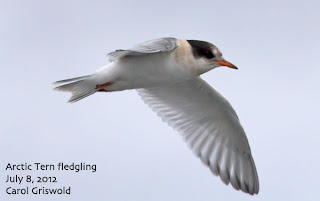Seward,
Alaska Sporadic Bird Report
Sunrise
4:48 am, sunset 11:15 pm, length of day 18 hours, 26 minutes; tomorrow will be
3 minutes and 2 seconds shorter.
Weather:
Today, like the past several days, has been a potpourri of scattered light
showers, patches of sunshine, and quiet overcast. Temps remain in the high 40s
to low 50s; a fleece feels good. New snow spattered the high mountain peaks the
past few nights but it CAN'T be termination dust yet!
Sweet-scented
blooming lilacs contrast with the blizzards of tiny white willow seeds hurrying
the season along. The off-white lilac-like elderberry flowers and white
"cauliflower" clusters on the Mt Ashes have faded as the young fruits
start to mature into important fall and winter bird food. Wherever they grow,
the lupines, iris and red columbines are putting on an outstanding show.
The
recent Fourth of July celebration and the Mt Marathon Race attracted thousands
of people to Seward making July birding a bit challenging. I am amazed, however,
that the birds seem to thread their way around all the commotion, including
fireworks during the critical pre-fledgling period. In moments of quiet,
especially in the evening and very early morning, the peaceful and soothing
melodies of the HERMIT THRUSH and ROBIN floated through the air like balm.
VARIED THRUSH songs rang from spruce.
A
few TOWNSEND'S, YELLOW-RUMPED, WILSON'S and ORANGE-CROWNED WARBLERS continue to
sing. FOX, SONG, and LINCOLN SPARROWS manage to find time to belt out a few
songs in between gathering mouthfuls of insects and caterpillars for their
youngsters. I heard several WHITE-WINGED CROSSBILLS from the mountainside spruce
forest, but I could not see any. We did not have any this past winter, but
hopefully they are nesting nearby and will hang around this winter.
Stacy
Peterson visited Ava's hummingbird feeders this weekend and banded 14 individual RUFOUS HUMMINGBIRDS including one male and one female juvenile. Ava felt the hummers
were just starting to fledge as the season got such a late start, so she'll be
hoping for more soon. Stacy and his expert family team painted a water-soluable
white "liquid paper" dot on each bird's head to avoid stressing any repeats. Watch for these
temporarily marked birds within a 6 mile radius of the Seward Highway and
Nash Road and let me know if you see one. This is a very interesting project.
Keep changing your hummer feeder 4:1 sugar water solution so it's nice and
clean for the newly fledged hummers and their hungry moms.
Ava
also reported CHESTNUT-BACKED CHICKADEES, PINE GROSBEAKS (fledged and squawking
like a rusty wheel), PINE SISKINS, DOWNY and HAIRY WOODPECKERS (fledged and
already learning about her feeders), RED-BREASTED NUTHATCHES, TREE and VIOLET
GREEN SWALLOWS (almost ready to fledge) and "lots of baby everything!"
I
was very excited this afternoon to discover two blackbird-type birds that I did
not recognize at Fourth of July Beach (at the end of Nash Road on the east side
of Resurrection Bay). I shared the photos with Peregrine Joe and we mulled over
the dazzling possibilities. Regrettably, it wasn't anything good. But how
fortunate we are in Seward to NOT recognize juvenile EUROPEAN STARLINGS. We
just haven't had that problem yet. We occasionally get one or two in the
winter, but never in the summer and never juveniles. Ironically these invasive
birds were gleaning invasive and nasty caterpillars from rolled-up alder
leaves.
For what it's worth, a collection of starlings is called a murmuration. There is an incredible video of a massive murmuration at http://vimeo.com/31158841, fortunately filmed in Europe, not here.
For what it's worth, a collection of starlings is called a murmuration. There is an incredible video of a massive murmuration at http://vimeo.com/31158841, fortunately filmed in Europe, not here.
GREATER YELLOWLEGS cry "riddley, riddley, riddley!" and flash their white rumps as they fly.
Resident SAVANNAH SPARROWS pop up and perch lightly on beach ryegrass stalks, then dash away to find food for their young ones.
A
proud COMMON MERGANSER mom and her darling 4 ducklings paddle past, down from
the 7 she had on June 25th.
Adult
and juvenile BALD EAGLES gather along the tideline and streams in huge numbers.
I counted at least 80 birds today packed in like combat fishermen. Red salmon
are reported to be running; maybe they will get lucky.
I
was surprised to find a few of our "winter birds" already back at
Fourth of July Beach: 2 WHITE-WINGED SCOTERS, uncommon for us, and the more
common SURF SCOTERS, feeding quite close to shore with a few HARLEQUINS.
A
beautiful breeding plumage COMMON LOON preened and stretched, waggling its huge
webbed foot, unconcerned about paparazzi. I understand the pair of common loons
at Bear Lake were unsuccessful this year at raising a family. The intrusion of
jet skis and other water sports is thought to be a large part of the problem.
So perhaps this loon has nothing to do but wait to try again next year.
A
RED-FACED CORMORANT, non-breeding, likes the old pilings close by the public
boat ramp at the SMIC boat basin. The bird has a thicker and lighter bill than
a pelagic cormorant, and its neck looks thicker too.
Finally,
I saw a TRUMPETER SWAN at the Mile 1 Nash Road yesterday. Two swans have been
spotted intermittently this summer, so hope springs eternal that there might
possibly be cygnets soon.
Summer
is speeding by; save a little time to savor it!
Happy
Birding!
Carol
Griswold
Seward
Sporadic Bird Report Reporter














No comments:
Post a Comment